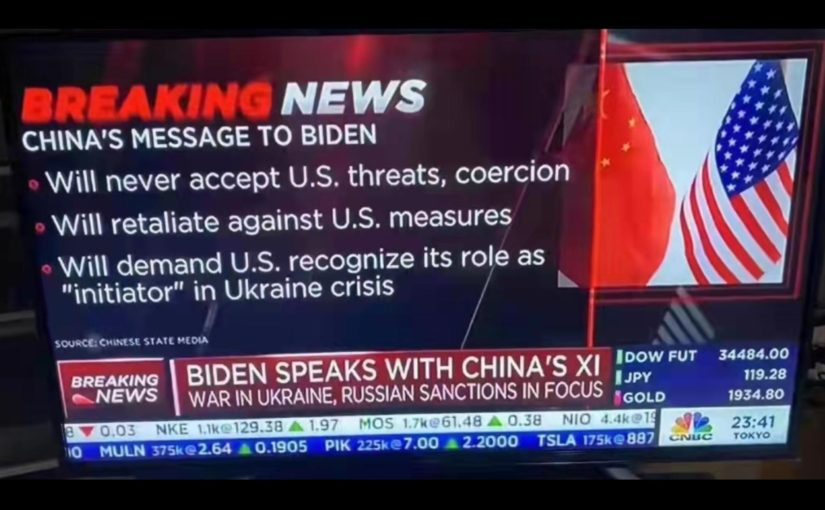I hope and trust that you all are also visiting my Metallicman You-Tube, and considering my Metallicman Patreon site . As well as this (here) MM site.
The You-tube Metallicman is (of course) all free. Videos discuss various subjects ranging from Geopolitical issues, to China, to cats, and social issues of the day.
And the Metallicman Patreon focuses on the world-line travel, souls, extraterrestrials, mysteries, the Domain, Prayer Affirmations, and OOPARTS aspects of Metallicman. While many of the videos and content provided there are for subscribers, not all are.
All in all, I hope that you will gain some benefit in visiting this trio of web-sites.
We continue on our daily briefing of the crazy discord that is flooding and saturating the world right now.
Daegon Magus
First up; DM was interviewed on You-Tube. He’s still “alive and kicking”, and doing well. He is embroiled in a ton load of changes (and of course, I associate that they are tied to his affirmation campaigns of the last year or so). But he’s doing well. So go ahead and watch his interview…
Pabellon Criollo – Venezuela’s National Dish
"...My take on the national dish with lots of variations. Tender, stewed cumin flavored beef with bacon-y black beans, caramelised plantain and rice. to mop up the juices. Cook this up next Independence Day!"
Expectations
I fully expect an almost exact repeat of the Ukraine debacle in Taiwan. Before the next U.S. Presidential election, the Neocon idiots in the Biden administration will deliberately or accidentally trigger a proxy war with China, which the U.S. will lose. Until the toxic Neocon ideology of the Washington Blob is exorcised, the U.S. will face an unending series of foreign policy disasters. -HH
Jeff and his Hemi-Sync / Self-Hypnosis explorations
I like Jeff and he writes on a great number of Go-Political issues. I have linked to him on numerous occasions. He has taken advice on the self-hypnosis, and mind centering techniques that I promote and he has told me that he doesn’t really know whats going on, but that he feels far better using the techniques.
Today, I got this from him…
Really fascinating. My Huawei watch analyzes sleep. Check out the right side of the attached graph, starting at 6:02, when I started my self-hypnosis. It is impossible for me to sleep on my back, yet my hypnosis mimics deep/light sleep and I even have REM! Don’t know where the semi-consciousness periods happen, but I am clearly not in an awakened state. Thought you might find this interesting.

.
LEGO’s Gorgeous Colossal Millennium Falcon Set Is A Mind-Numbing 7,541 Pieces

Lego has released a new Millennium Falcon set that’s bound to impress any Star Wars fan. This was released a few years back, but gosh! What a kit!
Coming in at 7,541 pieces, Lego said that it’s the biggest Millennium Falcon set it’s ever released—the second-largest set, which was released in 2007, had 5,195 pieces—and when built will measure 8 inches high, 33 inches long, and 22 inches wide. Even before you build it, it’s big enough that Lego has suggested rolling it out on wheels. (In comparison, the Lego Millennium Falcon set released ahead of The Force Awakens had a respectable 1,329 pieces.)
The Millennium Falcon has touches of its roots in the original Star Wars trilogy as well as the newer one. It comes with both the circular and rectangular dishes that go on top of the ship, 11 buildable characters including two different Han Solo’s, Leia Organa, Chewbacca, Rey, Finn, BB-8, and two porgs, and plenty of the touches that are essential to the Falcon’s interior decorations. There’s even a few new additions made to the Falcon that may end up in The Last Jedi.





















4 Really Big Names That Are Warning That Major Economic Disaster Is Ahead
I hope that you are enjoying these beautiful summer weekends while you still can, because it appears that very troubled times are dead ahead. Simultaneously, inflation continues to spiral out of control even as economic activity in the U.S. dramatically slows down. Many have compared what we are currently experiencing to the “stagflation” of the 1970s, but the truth is that what we are facing will eventually be so much worse than anything that we went through back then. A meltdown of historic proportions is here, and as you will see below, some of the biggest names in the entire country are talking about it.
On Monday, the average price of a gallon of gasoline in the United States set another all-time record high…
The gas price spike keeps getting worse. The national average jumped to $4.87 a gallon on Monday, according to AAA. That’s up 25 cents in the past week and 59 cents in the past month. There are now 10 states where the average price of gasoline is $5 a gallon or higher, with the latest being Michigan and Indiana. Washington, DC, is also above $5, according to CNN.
A 25 cent increase in one week is just insane.
If we continue on this trajectory, the price of gasoline would go up about a dollar a month.
I can’t imagine that will be the case, but stranger things have happened.
Overall, the average price of a gallon of gasoline in the United States has now more than doubled since Joe Biden entered the White House.
How high will it be a year from now?
For a long time I warned my readers that the price of gasoline would eventually hit ten dollars a gallon, but now we have learned that it is already almost there at one gas station in California.
Meanwhile, U.S. economic activity is really slowing down and we are being warned to brace ourselves for the worst.
In fact, at this point some of the most prominent people in the entire country are starting to sound like they could be writing for The Economic Collapse Blog. The following are four really big names that are warning that major economic disaster is ahead…
#1 If you have a “bad feeling” about the U.S. economy, you are not alone. Elon Musk says that he has a “super bad feeling” about where the U.S. economy is heading, and so he intends to reduce the Tesla workforce by approximately 10 percent…
Tesla CEO Elon Musk has a “super bad feeling” about the economy and wants to cut about 10% of jobs at the electric carmaker, he said in an email to executives on Thursday seen by Reuters. The message came two days after the world’s richest man told employees to return to the workplace or leave the company.
#2 I never imagined that I would write about something that rapper Cardi B said on this website, but that is precisely what I am about to do. At one time she was a huge Biden supporter, but on Sunday she publicly suggested that the U.S. economy is about to enter a recession…
Rapper and Joe Biden supporter Cardi B took to Twitter on Sunday to ask when “they going to announce” that the United States is “going into a recession.” “When y’all think they going to announce that we going into a recession?” Cardi B wrote Sunday in a tweet, which has since garnered more than 120,000 likes, and over 16,000 retweets.
Actually, the U.S. economy contracted during the first quarter of 2022, and if it contracts again in the second quarter then we are actually already in a recession right now.
#3 I really admire author Robert Kiyosaki, and his advice has helped millions of people all over the globe. In the past he was known for his relentless optimism, but now he is almost as pessimistic about our economic future as I am. For example, he tweeted out the following back on March 8th…
DO YOU HAVE a PLAN “B”? We are in BIGGEST BUBBLE in world history. Bubbles in stocks, real estate, commodities & oil. FUTURE? Possible DEPRESSION with HYPER-INFLATION. My PLAN B: be an entrepreneur, stay out of stock market, create own assets, use debt as $, save G,S, BC, guns.
Then he followed that up with this gem on March 13th…
BRANDON & FED want INFLATION to pay off trillions in debt. BEST INVESTMENT may be stocking products you will always use such as toilette paper, trash bags, canned goods, frozen foods, gold, silver, Bitcoin. I do not trust Brandon or Fed. They are Marxists. End the Fed & Brandon.
And then on April 15th he boldly declared that a “hyper-inflation depression” has arrived…
Wiley COYOTE moment coming. Biggest Bubble Bust coming. Baby Boomer’s retirements to be stolen. $10 trillion in fake money spending ending. Government, Wall Street & Fed are thieves. Hyper-inflation Depression here. Buy gold, silver, Bitcoin before the coyote wakes up. Take care
Of course he is dead on accurate about where the economy is heading. I don’t share his optimism about Bitcoin, but otherwise I think that the things that he has shared are very wise.
#4 The crisis that we are now dealing with did not arrive overnight. For years, many of us have been relentlessly warning about debt levels, the destruction of our currency, and the foolish decisions that our leaders were making. Now we are facing the largest debt bubble in all of human history, and there is no easy way out. On Monday, some thoughts that Kim Dotcom shared on Twitter went viral all over the Internet…
Let’s do the math: US total debt $90 trillion US unfunded liabilities $169 trillion Total $259 trillion Minus all US assets $193 trillion Balance – $66 trillion That’s $66 trillion of debt and liabilities after every asset in the US has been sold off.
I might quibble with the precise numbers that he used a little bit, but overall Kim Dotcom is right on target.
And I really like how he summarized the nightmare that is in front of us…
So even if the US could sell all assets at the current value, which is impossible, it would still be broke. The US is beyond bankrupt. This patient is already dead. This patient is now a zombie. You probably wonder why are things still going? Why didn’t everything collapse yet. It’s all perception, denial and dependency.
Our leaders have tried to keep the party going for as long as they possibly could, and for a while that actually worked.
But now a day of reckoning has arrived, and a horrifying economic meltdown has begun.
We aren’t talking about a “recession” that will be here for a while followed by a return to the way that things used to be.
No, what we are heading for is the sort of immense economic nightmare that I have been warning about for years.
Many Americans will be greatly surprised by how rapidly things totally fall apart, but the real surprise has been that it has taken us so long to get to this point.
You can’t defy the laws of economics forever, and we are about to see the greatest debt pyramid that the planet has ever seen come crashing down all around us.
Barflies bantering about Ukraine…
Biden's best bet now is to topple Zelensky, say there's been a coup then head off to try his luck with China. :) Who knows, Perhaps the Biden admin and the Euro twits will be foolish enough to sanction China as well. -Peter AU1
US imports from China rose to an all-time record after seasonal adjustment in April, despite the Shanghai lockdown
China exports to US jump, contrary to press reports By David P. Goldman US imports from China rose to an all-time record after seasonal adjustment in April, despite the Shanghai lockdown and other Covid-related blockages in the Chinese economy. That isn’t what you read in Bloomberg News, whose 30 economists and 100 full-time economics reporters apparently haven’t learned the difference between seasonally adjusted and unadjusted data.
Found HERE
This Modern Japanese Fishing Boat Designed With Graphic Motifs

Have you ever seen a fishing boat with so much style? Nendo design studio has transformed the Japanese fishing boat Shofukumaru into a true work of art.

The crew of such a ship usually stays at sea for about ten months, a heavy ordeal both physically and mentally. Most of the young crew members do not come back on a second mission. It was therefore asked to create a ship that would attract young members and reduce their stress.

The ship was covered by a linear pattern that emphasizes the curve of the hull. The rest was decorated with Japanese patterns from the hull to the interior of the ship.

The design has a lot of straight lines, a shape that could remind of life ashore (straight lines of buildings, windows, screens…) which could then comfort the crew. A beautiful story proving that art is an element that can improve the comfort at work.





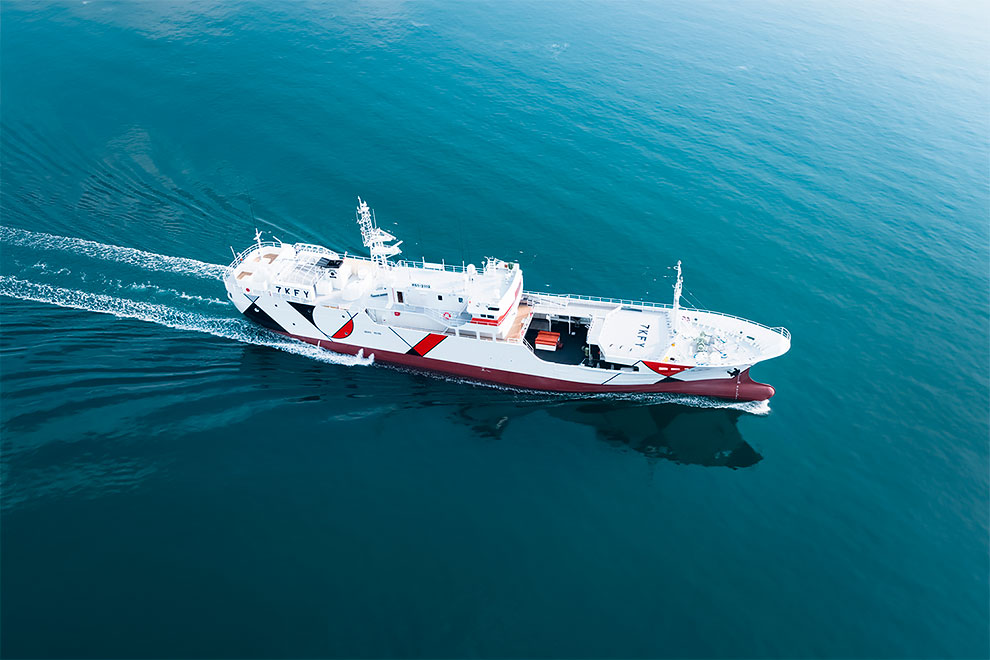

Military aircraft crashes in California
A military aircraft, originally reported to be carrying nuclear material, but subsequently reported to NOT be carrying nuclear material, has crashed in California, leaving officials to believe all five passengers are dead.
The plane crashed in Imperial County near Highway 78, preliminary reports indicate.
Officials believe at least five people were aboard at the time of the crash.
Investigators have presumed all passengers are dead.
It is unknown what caused the crash.
Original reports claimed the plane was carrying nuclear material. The military now says that is false. They now say the plane DID NOT have any nuclear material onboard.
Military officials are currently at the scene of the crash and an investigation is underway.
The crash happened near Highway 78 and Coachella Canal Road.
I don't know what to think. But disinformation; contel is normal with the United States today. -MM
Long term consequences…
Europe and Russia are natural trading partners, so the U.S. has accomplished, at great expense, a gross distortion of trade relationships that is inflicting major damage on the EU economy. This is likely to result in political turmoil in EU states as economic conditions worsen. When Europeans awaken to the fact that they have been played by the U.S., the blowback may result in the disbanding of NATO. The U.S. oligarchs who backed the Neocon project of global liberal hegemony will eventually realize that they have created an ideological monster that will seriously damage the U.S. economy. The toxic Neocon foreign policy that benefits only the defense sector (5% of the U.S. economy) will increasingly disrupt the global commerce on which much of the rest of the U.S. economy depends. The only question is how much damage the U.S. sustains before the Neocons are finally driven out of power. - HH
ASML looks to expand China operations in Beijing and Shanghai
What’s all this United States nonsense about keeping high end chip fabricators out of the hands of the Chinese?
BEIJING — ASM Lithography of the Netherlands is expanding its presence in China by setting up its first direct sales office in Tianjin, and the Dutch company is also working on plans for locations in Beijing and Shanghai, according to ASML officials. In the port city of Tianjin, ASML has a significant installed base of exposure tools at Motorola Inc.'s new MOS17 fab. This month, Motorola is expected to begin processing its first 8-inch (200-mm wafers in MOS17, which is being prepared for chip processing with 0.35- and eventually 0.25-micron technology. ASML is also in the hunt for new business in Shanghai and Beijing. “The China market looks good for us,” said Rodney Chisholm, technical sales support manager for Asia at ASML, in an interview at last week's Semicon China 2001 trade show in Beijing.
Ukraine President’s Inner Circle Buying Multi-Million $ Mansions in Switzerland!
.
If Ukraine is winning the war with Russia, then why are key people in President Zelensky’s inner circle buying houses in Switzerland? Oh, and how are they affording $9 million for those houses? Is U.S. “foreign aid” being stolen so they can buy multi-million dollar mansions?
Like most countries, Switzerland has land registry records showing who owns a particular property, how much it sold for, and what taxes are paid on it. Extracts from those land registries can be accessed by the general public.
Among the owners of luxury real estate in the country of banks and alpine meadows, are high-ranking officials from Zelensky’s entourage.
We begin with Dmitry Razumkov, a Ukrainian politician and former Chairman of the Verkhovna (Legislature).
According to land registry extract Mr. Razumkov seems to have bought himself a luxurious home for 8,954,621.00 Swiss Francs, which are about equal to the value of a U.S. Dollar. His name is at the bottom of the property sale record:
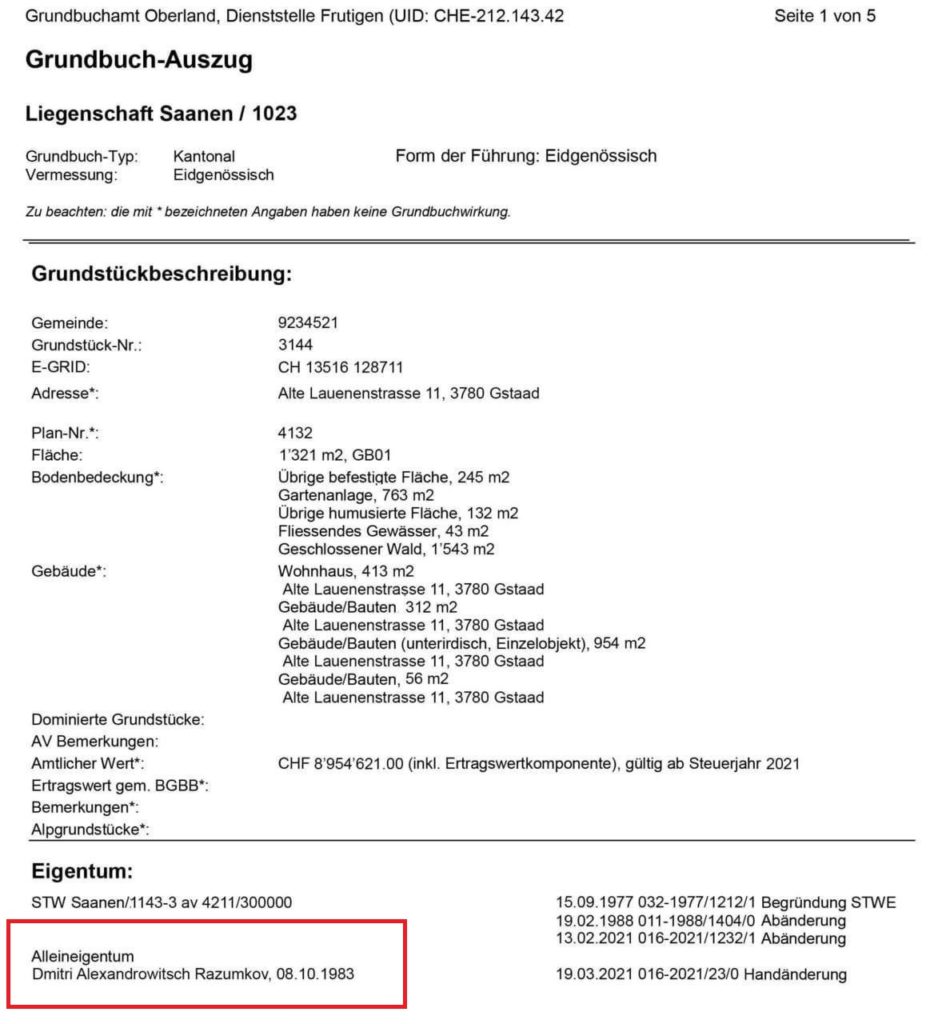
Next is Oleksandr Danyliuk (Daniljuk) former Secretary of the National Security and Defense Council (NSDC) of Ukraine. His name appears as the buyer of the 9,126,538.00 CHF home shown on the record below:
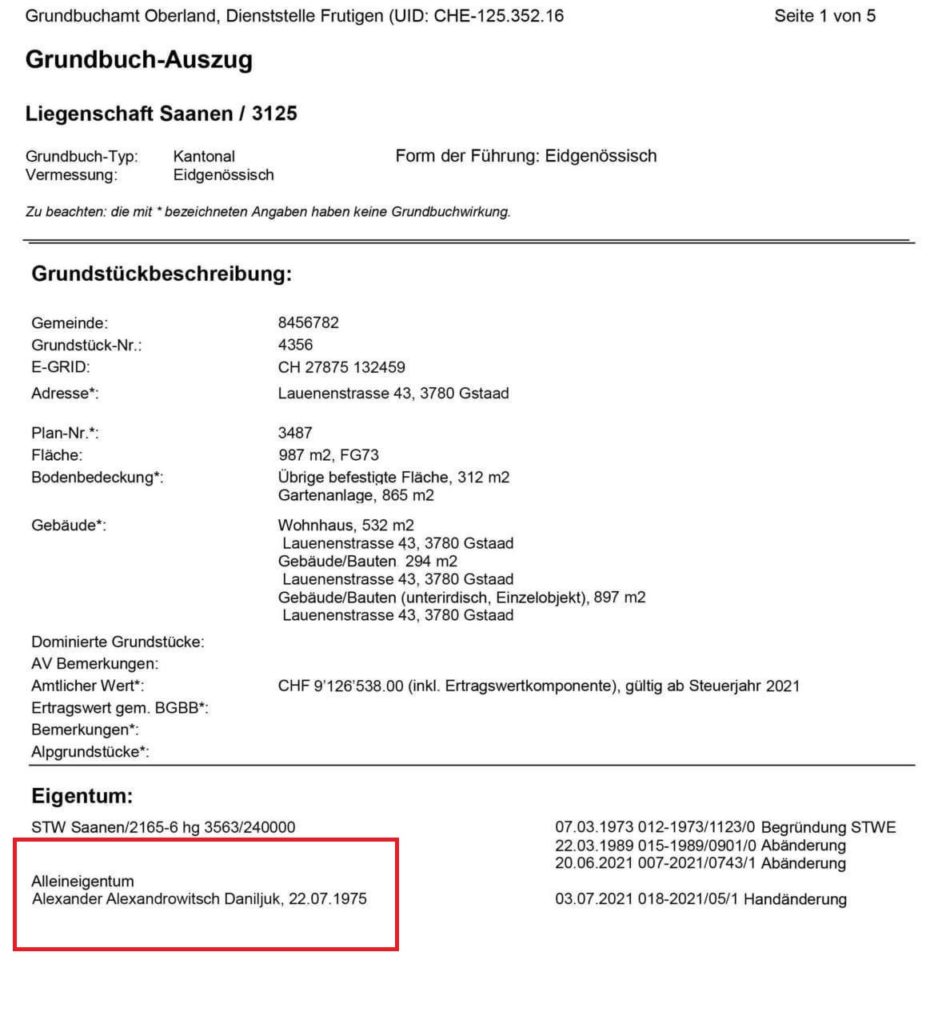
Next is the record for Lyudmila Denisova, the same ombudsman who was fired because of false reports about the atrocities of the Russian army against children.
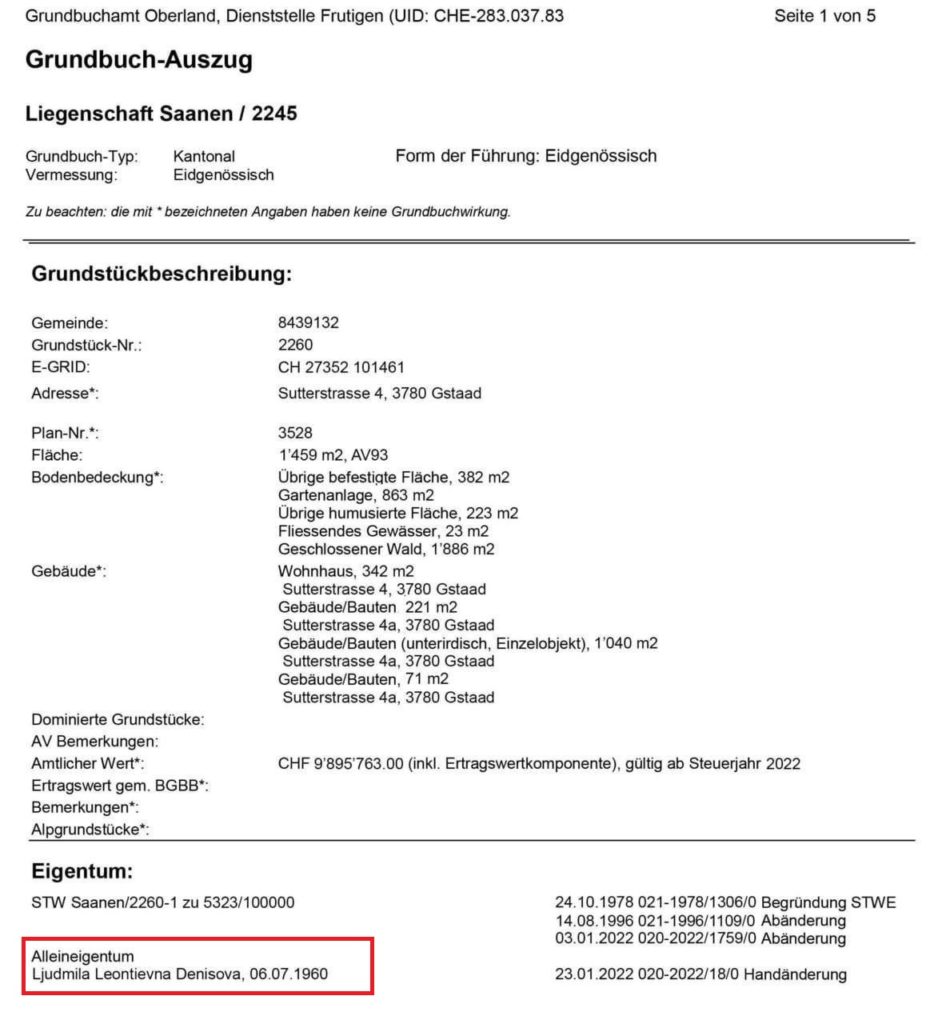
The cost of each home is about 9 million Swiss francs. The franc is currently almost equivalent to the dollar.
They love Ukraine so much that they decided not to live in it.
Not only that, where did these “public servants” come up with about $9 million to get themselves mansions in Switzerland?
Most of these homes were purchased just BEFORE Russia began its Special Military Operation into Ukraine.
Were these homes some sort of Bribe or Payoff to these public officials to get them to sell-out Ukraine by stoking the fires until war broke out? Were these public officials paid-off by someone to get them to help start a war?
Or worse, did foreign aid to Ukraine get stolen so these people could buy luxurious mansions for themselves, far away from the war they helped start?
Inquiring minds want to know.
The Dadbag, A Fanny Pack That Looks Like An Exposed Daddy’s Belly

This is the Dadbag, the brainchild of designer Albert Pukies, which I did just a little bit in my mouth right now. Each bag looks like the exposed stomach of a man, and come in a variety of skin tones, hairiness, and plumpness.
At the time of this writing, the Dadbag isn’t commercially available yet (Pukies is still looking for production partners), which is a shame for everybody who saw this and thought, “I must have one of those,” and a real blessing to everyone who didn’t.
Keep going for several more shots including the different options.






David Cross: Why America Sucks at Everything
The video resonates with me. Sorry.
Healthy young people are dying suddenly and unexpectedly from a mysterious syndrome – as doctors seek answers through a new national register
- People aged under the age of 40 being urged to go and get their hearts checked
- May potentially be at risk of having Sudden Adult Death Syndrome (SADS)
- SADS is an ‘umbrella term to describe unexpected deaths in young people’
- A 31-year-old woman who died in her sleep last year may have had SADs
By TOM HEATON FOR DAILY MAIL AUSTRALIA
PUBLISHED: | UPDATED:
People aged under 40 are being urged to have their hearts checked because they may potentially be at risk of Sudden Adult Death Syndrome.
The syndrome, known as SADS, has been fatal for all kinds of people regardless of whether they maintain a fit and healthy lifestyle.
SADS is an ‘umbrella term to describe unexpected deaths in young people’, said The Royal Australian College of General Practitioners, most commonly occurring in people under 40 years of age.
Russia Deploys S-400 Air Defense on “Snake Island”
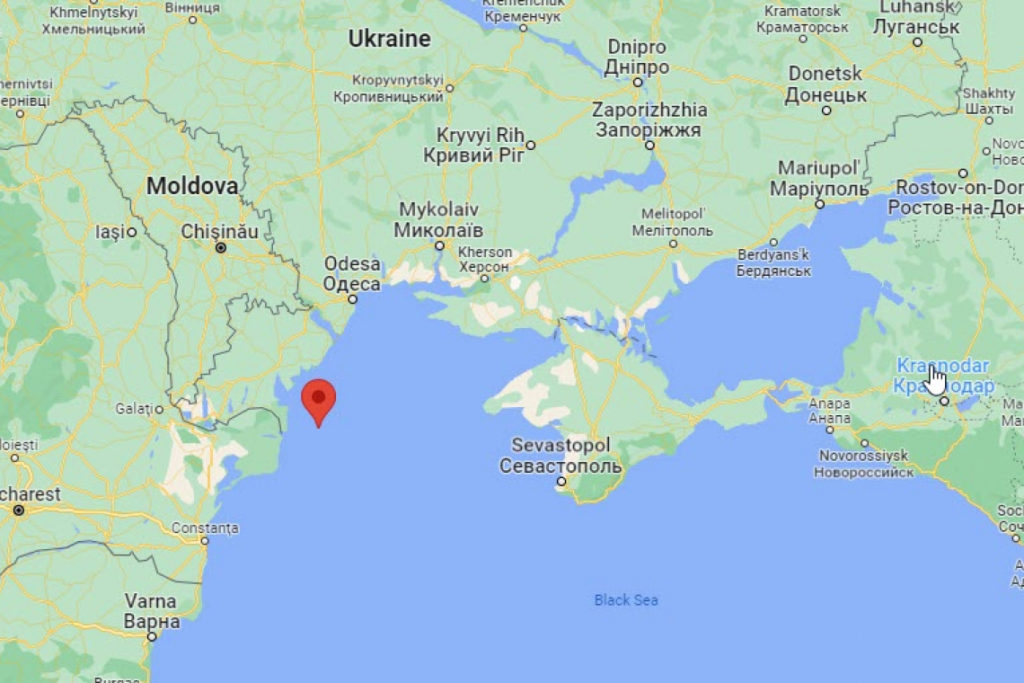
Snake Island, also known as Serpent Island or Zmiinyi Island, is an island located in the Black Sea off the coast of (what used to be) Ukraine, near the Danube Delta, with an important role in delimiting what (used to be) Ukrainian territorial waters. It is now Russian and Russia means to keep it.
The island has been known since classical antiquity, and during that era hosted a Greek temple to Achilles.
In the Special Military Operation that Russia began in February to de-militarize and de-Nazify Ukraine, the island became the focus of storied battles; with Ukraine claiming their soldiers bravely faced-off against Russian naval vessels, which allegedly killed all the Ukrainian defenders.
Of course, that story proved false, when Russia released unharmed, all the soldiers from Ukraine they had taken prisoner when Russia conquered the island.
During the ongoing hostilities between Ukraine and Russia, several high profile attempts were made by Ukraine to retake the island. All failed.
This week, Russia deployed its famous S-400 air defense system on the island. The S-400 is widely known as the most accurate and deadliest air defense system in the world.
Looks as though Russia means to keep what it has, and the S-400 seems perfectly able to make sure it does.
India-US to hold high-altitude military exercise amid China’s ‘alarming’ build-up along LAC
This REEKS of CIA disinformation. -MM

New Delhi: Noting that the Chinese military’s infrastructure build-up under its Western Theatre Command — that looks after India — was “eye-opening and alarming”, a top visiting US Army officer Wednesday said the Indian and American Army will train together this year at 9,000-10,000 feet to increase interoperability for high-altitude warfare.
Pitching for a strong operational bond between the two armies in the Indo-Pacific region instead of only focusing on the naval interoperability, US Army Pacific Commanding General Charles Flynn termed China’s build-up near Ladakh and strengthening of its military infrastructure as part of Beijing’s “corrosive and destabilising behaviour”.
Pointing out that he has been part of the Pacific Command since 2014 under various ranks, Gen Flynn said, “When I sort of look back on what the CPC (Communist Party of China) and the PRC (People’s Republic of China) were doing, compared to what they are doing today, they have taken an incremental and insidious path and destabilizing and corrosive behaviours that they project into the region are simply not helpful”.
Interacting with a select group of journalists, the senior US Army officer who will be visiting the crucial Eastern Command tomorrow also spoke on the Ladakh situation.
When asked about the Chinese buildup along the Line of Control (LAC) and construction of villages in Bhutan, the officer said he believed “that activity level is eye-opening”.
“Some of the infrastructures that is being created in Western Theatre Command (WTC) is alarming. And so much like across all of their military arsenal, one has to ask the question why. I don’t have a crystal ball to say how it is going to end or where it will be but I will say, it is worthy of asking that question and trying to get a response as to what their intentions are,” he said.
Talking about the ongoing military and diplomatic talks between India and China to resolve the Ladakh crisis that has entered its third year, he said it is helpful but Chinese actions and words don’t match.
“I think the talks that are going on are helpful but behaviour matters here as well. I think my understanding is that what they are saying is one thing but the way they are acting and behaving in a way of build-up is concerning and it is concerning to everyone. Obviously, there has been tension and we have to pay attention to that,” he said.
Article HERE
The Worst Economic Gloom In 50 Years
We haven’t seen anything like this in decades. Energy prices are soaring to unprecedented heights. Food shortages in some parts of the world are starting to become quite severe. Rampant inflation is out of control all over the globe. Meanwhile, economic activity is slowing down everywhere that you look. Some are comparing this current crisis to the “stagflation” of the 1970s, but I believe that is a far too optimistic assessment. Just about everyone can see that economic conditions are rapidly deteriorating, and there is a tremendous amount of alarm about what the months ahead will bring.
According to a brand new Wall Street Journal-NORC survey that was just released, the percentage of Americans that believe that the state of the U.S. economy is “poor or not so good” is 83 times larger than the percentage of Americans that believe that the state of the U.S. economy is “excellent”…
A severe pessimism grips the U.S. economy and Americans report the highest level of dissatisfaction with their financial situation in at least half a century, poll results released Monday show. Eighty-three percent of Americans describe the state of the economy as poor or not so good, according to a Wall Street Journal-NORC Poll. Only one percent describe the economy as “excellent.”
I would like to talk to someone from the one percent of Americans that still believe that the U.S. economy is in “excellent shape”.
To me, it is always fascinating to find someone that can completely deny reality even when all of the evidence points in the other direction.
The same survey found that the percentage of Americans that are “not at all satisfied with their financial condition” is the highest in at least 50 years…
Thirty-five percent said they are not at all satisfied with their financial condition, the highest level of dissatisfaction since NORC began asking the question every few years starting in 1972. Sixty-three percent of Americans say they are extremely or very concerned about the price of gas. Fifty-four percent say they are extremely or very concerned about the impact of high grocery prices on their household’s financial situation. Just 13 percent say they not very or not at all concerned about gas prices and 19 percent about grocery prices.
In other words, this is the gloomiest that Americans have been about their own personal finances in at least five decades.
Wow.
One of the big reasons why people feel this way is because the price of just about everything is going up.
In particular, the price of gasoline has been making national headlines just about every day. On Tuesday, it set another brand new record…
The national average price of gas is now $4.955, reflecting an over three-cent jump overnight, 28-cent rise in the last week, and nearly 64-cent rise in the last month. Diesel also hit another record on Tuesday, reaching $5.719. Currently, 16 states are experiencing an average price of gas of $5.00 or more. That includes Maine ($5.023), Massachusetts ($5.21), New Jersey ($5.032), Pennsylvania ($5.031), Michigan ($5.214), Ohio ($5.061), Indiana ($5.234), Illinois ($5.532), Idaho ($5.025), Alaska ($5.469), Hawaii ($5.493), Washington ($5.489), Oregon ($5.485), Nevada ($5.564), Arizona ($5.181), and California ($6.390). California’s Mono County appears to be reporting the highest gas price average in the Golden State — $7.213.
Unfortunately, there is a growing consensus among the experts that this is just the beginning. Here is one example…
With the summer travel season just getting underway, demand for gasoline, coupled with the cut-off of Russian oil shipments due to the war in Ukraine, is sending oil prices higher on global markets. The national average for gasoline could be close to $6 by later this summer according to Tom Kloza, global head of energy analysis for the OPIS, which tracks gas prices for AAA.
And here is another example…
GasBuddy head of petroleum analysis Patrick De Haan provided insight into record-high gas prices, warning on Wednesday that “we’re going to be swimming in these high prices for a while.” Speaking on “Varney & Co.” on Wednesday, De Haan also revealed his forecasts for how high prices at the pump will climb, arguing that they could reach a national average of $6 a gallon in the coming months, but “what seems like more of a guarantee is that $5 mark.”
Others are even more pessimistic. In fact, the head of commodity trading giant Trafigura just warned that the price of oil could actually make a “parabolic ” move in the months ahead.
Needless to say, energy prices have a domino effect throughout the entire economy. When commentator Anthony B. Sanders contacted moving companies about his coming move out of state, he could hardly believe the quotes that he was given…
As I line up my move from Fairfax VA to Columbus OH, I am getting a variety of quotes from moving companies. And wow! The cost of moving using a national moving company for a 4 bedroom house is $15,000 to $20,500. That includes International, North American and Bekins. One of the reasons for the high cost of moving is the massive increase in diesel fuel used for trucking. Diesel fuel under Biden has risen 117%. And since it was revealed that natural gas often is used for electric charging stations, and NATGAS is up 281% under Biden (but there aren’t many electric moving trucks yet).
Could you imagine paying $20,000 to move from Virginia to Ohio?
In the old days, you could purchase your own new vehicle for that much money.
In this crazy environment, some companies are attempting to hide inflation by shrinking their package sizes…
“Joining the parade of downsized products is cereal stalwart Honey Bunches of Oats, which has seen the weight of its standard box, previously 14.5 ounces, lessen to 12 ounces — a reduction of roughly 17 percent,” the U.K. paper said. Angel Soft toilet paper has also reduced its size from 425 sheets per roll to 320, while Bounty paper towels have cut their rolls from 165 sheets per roll to 147 late last year. Gatorade also cut its bottle size from 32 ounces to 28 ounces.
Do they actually believe that we will not notice that the packages have changed?
And this isn’t just happening here in the United States. At this point, this is taking place all over the globe…
In the U.S., a small box of Kleenex now has 60 tissues; a few months ago, it had 65. Chobani Flips yogurts have shrunk from 5.3 ounces to 4.5 ounces. In the U.K., Nestle slimmed down its Nescafe Azera Americano coffee tins from 100 grams to 90 grams. In India, a bar of Vim dish soap has shrunk from 155 grams to 135 grams.
Our standard of living is falling with each passing day, and that process is only going to accelerate during the second half of this year.
In a desperate attempt to keep living the way that they always have, many Americans are turning to their credit cards at an alarming rate.
Needless to say, that is only a short-term solution.
And at the same time, overall economic activity continues to slow down…
A closely followed measurement from the Atlanta Federal Reserve Bank suggests the economy could be headed for a second-quarter decline in gross domestic product, the broadest measure of goods and services produced in a country. The GDPNow tracker shows the economy grew at an annualized pace of just 0.9% in the spring, a steep decline from its previous estimate of 1.3% on June 1.
If U.S. GDP is actually negative for the second quarter, that will be two quarters in a row, and that will mean that we are officially in a recession right now.
But what we are heading into in 2023 and beyond is not going to be just a “recession”.
Ultimately, we are heading into the sort of “nightmare scenario” that I have warned about for years.
It took decades of very foolish decisions for us to reach this point, and our leaders in Washington continue to make very foolish decisions.
So the truth is that there are no long-term solutions in sight.
Only pain.
So if the American people are this upset about the economy now, how will they be feeling six months down the road?
China deployment of missiles system in Cambodia
Tiktok video HERE.
Venezuelan Arepas | The Frugal Chef
This is easy to make and a great unique taste!
BRITISH MERCENARIES IN UKRAINE SENTENCED TO DEATH

Two British mercenaries, Aiden Aslin and Shaun Pinner, who went to assist Ukraine in the attacks against Luhansk and Donetsk, have been found guilty of “trying to seize power” and have been sentenced to DEATH by the Supreme Court of Donetsk People’s Republic (DPR).
“We have said continually that prisoners of war shouldn’t be exploited for political purposes,” a spokesman for Prime Minister Boris Johnson said.
“Under the Geneva Convention prisoners of war are entitled to combatant immunity and they should not be prosecuted for participation in hostilities.
“So we will continue to work with the Ukrainian authorities to try to secure the release of any British nationals who were serving in the Ukrainian armed forces and who are being held as prisoners of war.”
Foreign Secretary Liz Truss said the court verdict was a “sham judgment with absolutely no legitimacy”.
Aslin, 28, and Pinner, 48, and Moroccan national Saaudun Brahim, have been found guilty of being mercenaries and taking action towards violent seizure of power.
They were sentenced in a court in the Russian-backed self-proclaimed Donetsk People’s Republic that is not internationally recognized.
HAL TURNER EDITORIAL OPINION
I bet when they’re executed, they will be just as dead as if the Donetsk People’s Republic WAS “internationally recognized.”
This is what happens when people stick their nose into the affairs of others. Aslin and Pinner are not Ukrainian; they’re British. Both men went to Ukraine with the express intent to side with Ukraine in a war zone, yet neither man joined the Ukraine military. As such, they are not covered by the Geneva Convention because they were not members of a sovereign military engaged in war.
Put simply, these two guys thought it would be cool to live action role play (LARP) and now they’re going to be executed for what they did.
Clearly, had they minded their own business, none of this would be happening. This is what can happen to people who don’t mind their own business.
Venezuelan Pulled Beef Recipe – Easy Arepa Recipe
To go with the delicious Arepas presented earlier.
Why?
Well people… This is why.

Execution for war crimes: Ukrainian foreign mercenaries sentenced to death
The trial of British and Moroccan mercenaries in Donetsk turned out to be very quick. The trial of British and Moroccan mercenaries in Donetsk turned out to be very quick. It took the Supreme Court of the DPR just a few days to sentence two subjects of the British crown - 48-year-old Sean Pinner and 27-year-old Aiden Eslin - and a citizen of the Kingdom of Morocco to capital punishment - the death penalty. Recall that it exists in the DPR (and in the LPR) in wartime. Apparently, the reason for such efficiency lies in the good work of the investigation at the preliminary stage. Moreover, the investigators had a very rich evidence base. All three mercenaries surrendered in Mariupol as part of the 36th Separate Marine Brigade of the Armed Forces of Ukraine, leaving the cellars of Azovstal. And with them, thousands of witnesses of their service surrendered. It was their testimony that made it possible to establish that Sean Pinner, who spoke about his work as an instructor, was on the staff list as a sniper. No one was touched by the lyrical story of Aiden Eslin, who ended up in Ukraine after he fell in love with a girl from Ukrainian Nikolaev and decided to join his life with her. For which he could not think of anything better than to serve as a mercenary and kill the tribesmen of his beloved. The Moroccan Saadoun Brahim, as his father said, came to study as an astronaut, but, due to the absence of an astronaut in Ukraine as such, and training in this profession, he also became a mercenary. The Moroccan had no luck with space, but it seems that the earth called him to her. By the way, all of them admitted partially their guilt in committing the charges brought against them. According to the legislation of the DPR, all those sentenced must be shot. At the same time, it is clear that this will not happen tomorrow or the day after tomorrow. The convicts have a month to appeal the verdict, then it will take some time to consider the complaint, then they will be given the right to file a request for pardon. And only after all these procedures are completed, the sentence will be carried out.
NATO JUST GOT THE BAD NEWS: EUROPEAN TANK PRODUCTION HALTED, LACK OF TITANIUM – FROM RUSSIA
The NATO Military alliance just got the rug pulled out from beneath its entire operation. It seems that Europe no longer has any Titanium, which is essential for the armor of tanks. In years past, Europe bought its Titanium from . . . Russia. They can’t buy it anymore. As such, tank production – in Germany – has stopped.
Yes, you read that correctly, Tank building in Germany, has stopped.
Hints that there was some type of undisclosed problem with European militaries started being visible when Ukraine asked for tanks, Armored Personnel Carriers and more from Europe and the United States, to fight Russia.
Germany refused to donate tanks to Ukraine, or to augment Poland, which did donate tanks to Ukraine.
Germany’s refusal to supply its heavy tanks to Poland was not at all caused by Berlin’s attempt to deceive Warsaw, but by the fact that Germany simply does not have titanium to build new tanks.
Some of my former colleagues in the Intelligence Community from my years working with the FBI Joint Terrorism Task Force (JTTF) tell me “due to the lack of titanium supplies from Russia, it is extremely problematic to establish the production of tanks in any required quantity today.”
Tanks require a fairly large amount of titanium, which is a component of the armor. However, due to the lack of supplies from Russia, this caused an almost complete halt in German tank building.
Moreover, a similar situation will soon occur in the UK, France, and other European countries.
HAL TURNER EDITORIAL OPINION
Bottom line: If Russia were to engage NATO in actual war, then NATO would be completely unable to build _any_ replacement tanks, once existing tanks were destroyed in battle.
The short and sweet of it: NATO cannot afford to fight Russia because NATO countries don’t have Titanium to use for armor in tanks and without tanks, NATO would flatly lose the war.
Period. Full stop.
This is kinda funny. Almost all of NATO is out there screeching like an old wash woman that “Russia baaaad.”
Then they all realized “Uh oh they supplied the materials we need to go kill them.”
Bahaha. The governments of the west: Fucking morons.
An outstanding discussion
You all must watch this lecture.
National Guard Placed on Ready-Go Alert for Supreme Court Abortion Ruling
The National Guard in all fifty (50) U.S. states has been told to adopt a “Ready-Go” posture for deployment in preparation for the soon-to-be-released US Supreme Court ruling on Abortion.
The Court is expected to overturn the precedent of Roe v. Wade” which made Abortion legal.
If and when such a ruling comes out, it is widely speculated that the pro-abortion, kill-the-babies-on-demand crowd of spoiled brats. will take to the streets and riot, nationwide.
While overturning Roe v. Wade will NOT make Abortion automatically ILLEGAL, it will put the issue back under state control, instead of the federal government, so individual state legislators can craft laws their citizens deem appropriate.
Developing . . . .
Russia’s nuclear threat has worked | The Strategist
The war in Ukraine has reasserted the relevance of nuclear weapons as a major deterrent in global conflicts. For the first time since the end of the Cold War, a great power has publicly threatened to deploy tactical nuclear weapons. And the threat worked: the West has been carefully calibrating its arms supply to Ukraine in order to avoid giving Russia reason to resort to nuclear escalation. Russia’s unprovoked invasion of Ukraine wouldn’t have happened had Ukraine not surrendered its nuclear arsenal under the 1994 Budapest Memorandum on Security Assurances, which included American and Russian guarantees to respect and defend its territorial integrity.
Revolutionary powers such as North Korea and Iran have watched these developments closely. For Iran, a rising Shia power, its nuclear program represents an insurance policy against the surrounding Sunni powers, all allies of Israel and the United States. North Korea’s nuclear logic isn’t much different.
There are few realistic options for stemming the trend towards nuclear proliferation. One development that would make a difference would be for the five big nuclear powers to lead by example and start reducing their arsenals drastically. The obstacle here arises from the disparity between American conventional military might and that of China and Russia. For France and Britain, meanwhile, maintaining nuclear weapons is an issue of status.
If leaders of the calibre of Ronald Reagan and Mikhail Gorbachev—capable of overruling their respective security establishments—re-emerged, they could potentially lead such a non-proliferation movement. But such leadership doesn’t seem to be imminent.
Another possibility would be to establish a zone free of weapons of mass destruction in the Middle East. But that could happen only if agreements were reached on the major conflicts in the region, and Israel surrendered its supposed nuclear capabilities.
I’m not optimistic about any of these scenarios. Ultimately, however, whether a regime has nuclear weapons isn’t the main issue. It’s the nature of the regime that counts.
Ukraine made a mistake in entering negotiations with Russia at a very early stage of the war, when the impression was still that Russia’s military was unstoppable. A mutually harmful deadlock offers a better opportunity to reach a peace agreement. Unless Russia introduces nuclear weapons into the equation, we may be nearing such a deadlock, owing partly to the fact that the US and its allies have wisely calibrated their arms supply to prevent a Ukrainian defeat while not provoking Russia to escalate.
The Ukrainians should not enter negotiations if the price of admission is accepting Russia’s demand that they not join NATO. This should be a concession in a negotiating process, not a precondition to it.
That said, as I’ve argued recently, peace is about equilibrium and stability, not justice. The just outcome—Russia’s full withdrawal from Ukraine and reversal of its annexation of Crimea—would be political suicide for Putin and a tremendous setback for Russia’s international standing. Far from being a cooperative participant in a European security system, a defeated Russia, as a humiliated nuclear-armed superpower, would pose an enduring threat to it.
Western powers should be part of the peace process, not only because they are part of the conflict, but also because they are the ones with the power to compensate Russia for any concessions it makes. That compensation should come in the form of a European security system that addresses key Russian concerns and upholds the neutrality and territorial integrity of Ukraine, Moldova and Georgia. Finally, to deal with Ukraine’s dual identity, the ethnic Russian regions of Donetsk and Luhansk would have to enjoy significant autonomy within a federal state, as was stipulated by the 2015 Minsk II settlement.
For far too long, Europe has remained comfortably embedded in a ‘post-historical’ world, while outsourcing its security to American taxpayers. The war in Ukraine marks the end of the myth that history ‘ended’ with the end of the Cold War and the dissolution of the Soviet Union. It also vindicates the Latin adage, Si vis pacem, para bellum (‘If you want peace, prepare for war’). A strong and united NATO would help secure peace.
But any European security architecture that emerges from the Ukraine war must include buffer areas between Russia and NATO. Ukraine, which will probably have to abandon its aspirations for NATO membership as part of any peace settlement, should be one such zone. Sweden and Finland, with its 1,340-kilometre border with Russia, should be two more. The alternative is a long border in a permanent state of friction, war or the imminent threat of war.
For the foreseeable future, peace must be based on disengagement. The end of Europe’s dependence on Russian energy would contribute to peace, as it would force Russia to diversify its economic model, increase Russia’s stake in global stability, and drive the country to become a more active participant in the global economy.
Article HERE
US Threatens China With ‘Military Action’ If It Breaches The Red Line; Can US Navy Fight PLA On Its Home Turf?
Here's an "armchair warrior" analysis out of an anti-China publication out of India. Pretty pro-USA. Worth a read, and then a vomit. After all, since WHEN is Chinese territory a "Red Line"? As to the question being raised; "can the USN fight the PL"? Well, this was answered in 1950. Then the USA fought China in Korea. And the USA lost. And lost terribly. -MM
US President Joe Biden has said twice over the last year that Washington will militarily defend Taiwan in the event of a Chinese invasion attempt. His latest explicit security guarantee to Taiwan was made in Tokyo last week.
But does America have the military superiority over China in this part of the world to deliver what President Biden pledged?
This is a question that many security analysts in the US are asking, given the fact that the US Navy, which has to play the most important role in case China attacks Taiwan, is undergoing structural changes because of budgetary constraints that many consider will weaken both its capacity and capability in the near term.
Critics are pointing out that given the current threat, the fleet is not growing fast enough to meet the potential challenge of fighting competitors like China and Russia.
The US Navy recently released its long-awaited 30-year shipbuilding blueprint, providing three options for future fleet force structure.
The first option would yield an inventory of 316 ships by FY 2052, the second would yield 327 ships by FY 2052 and the third would yield 367 ships by FY 2052. However, the document of the blueprint notes that “the ability of the industrial base to support” the third option with the largest fleet size “has not been independently assessed,” this has worried the analysts.

Big Changes On The Anvil
The new shipbuilding plans show the Navy decommissioning two Independence-class LCS – USS Jackson (LCS-6) and USS Montgomery (LCS-8) – in FY 2024. Jackson entered the fleet in 2015, while Montgomery was commissioned in 2016. Both ships were built by Austal USA.
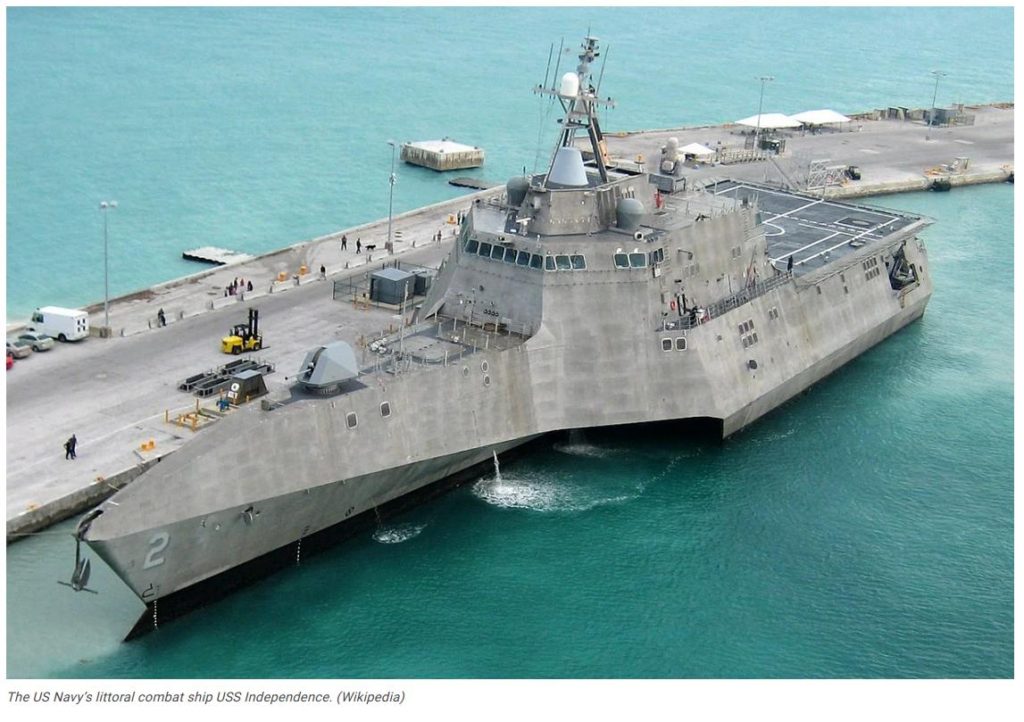
The Navy also wants to continue decommissioning its aging Ticonderoga-class cruiser fleet, starting with USS Antietam (CG-54), USS Leyte Gulf (CG-55), and USS Shiloh (CG-67) in FY 2024. Under the proposal, the Navy would decommission the entire cruiser fleet by the end of FY 2027, including the ones that are currently in the cruiser modernization program.
The blueprint shows the Navy decommissioning USS Nimitz (CVN-68) in FY 2025 and USS Dwight D. Eisenhower (CVN-69) in FY 2027, which aligns with the 50-year service lives for the Nimitz-class carriers.
According to the blueprint, the first two options would be for “a budget with no real growth,” while the third option “represents an additional $75 billion real growth beyond the [Future Years Defense Program] in FY2022 constant dollars.”
The document says that “The increased procurement level, informed by industrial base capacity and on-time and on-budget performance, achieves 326 manned battle force ships in the mid-2030s, and ultimately achieves 363 manned battle force ships in FY2045.”
Overall, the long-range plan shows the Navy decommissioning 13 ships in FY 2024, another 13 in FY 2025, 14 ships in FY 2026, and 13 in FY 2027. FY 2027 would also see the service decommission of USS Arleigh Burke (DDG-51), the lead ship of the class.
Fresh Procurement Schemes
The three procurement schemes show what ships the Navy could purchase between FY 2028 and FY 2032, a time frame the service is calling a “transition” period after the FY 2023 five-year spending plan, and between FY 2033 and FY 2052, which the Navy is calling the “future force design” time frame.
While the first two options only show the Navy buying one Ford-class aircraft carrier between FY 2028 and FY 2032, the third option shows the service purchasing one in FY 2028 and another in FY 2032.
“A decision on CVN 82/83 two-ship buy is required no later than FY25 and will be evaluated during upcoming force structure and industrial base studies,” the document reads. “The Department is reviewing Large and Small Surface Combatant and Attack Submarine procurement quantities in FY 2028-2032.”
The blueprint makes it clear that the US Navy is “prioritizing readiness before capacity”. It says, “Assuming no real budget growth, the two low ranges of the plan do not procure all platforms at the desired rate (e.g., DDGs, SSNs, and FFGs at two ships per year), which industry needs to demonstrate the ability to achieve, but do maximize capability within projected resources, industrial factors, and technology constraints to build the most capable force. Overall, this approach accepts risk in capacity to field a more capable and ready force.”
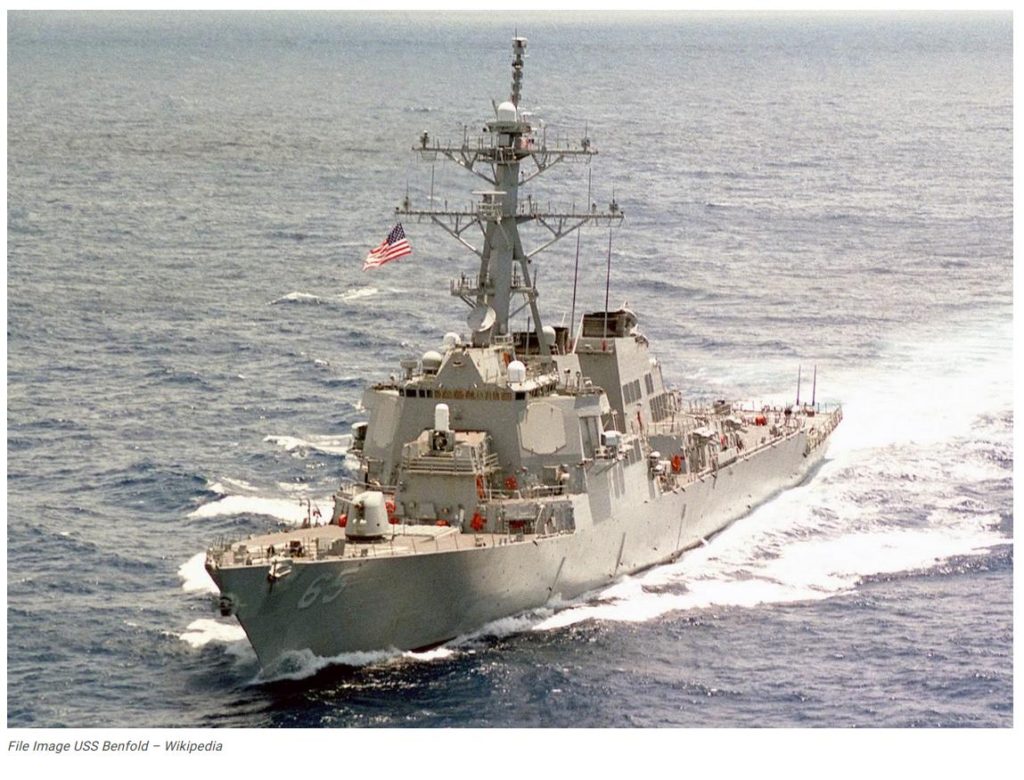
The 30-year blueprint talks of the US Navy having 327 ships by FY 2052. The Navy has always planned a goal of having more than 300 ships. But then the fact remains that the fleet has never achieved that goal since 2003.
China’s Massive Strength
In the year 2018, it had been said that with the People’s Liberation Army Navy (PLAN) adding more than 120 battle-force ships, the US should have at least 355 ships of which it was short of 57.
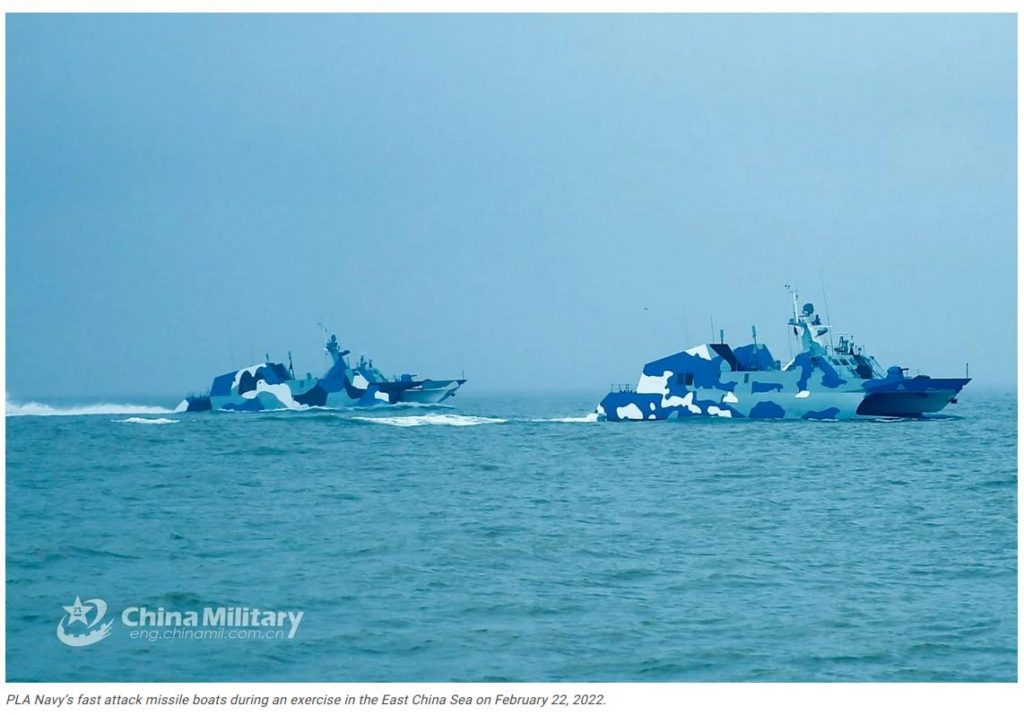
Over the last four years, the PLAN has further increased its strength. The Chinese have built a large fleet including aircraft carriers, cruise missile-armed surface ships, and several submarines. The PLAN is supported by land-based missiles and aircraft.
And that prompted the Trump administration in its final days to encourage the Navy to have a fresh force structure assessment. The Navy said accordingly that given the rising profile of the PLAN, it should have a figure between 382 and 446 manned ships and an additional 143 to 242 unmanned ships.
But within two years, the Navy seems to have changed its assessment. The US is driving down fleet numbers and ship production, the critics point out. They say that the average gap between ordered and achieved battle fleet size over the last five years was roughly 10 ships.
“Integrating the precipitous drop from 2022 to 2023 and loosely projecting that magnitude of 50 ships over five years shows a battle force of 275 ships or smaller”. It may be noted that at the moment the US Navy has 298 ships.
Major Gaps
Further, buried within the FY23 capacity gap is a lethality gap. As Congresswoman Elaine Luria (Democrat), who represents Coastal Virginia, home to the world’s largest naval base and who before running for Congress had served two decades in the US Navy, points out, “the U.S. Navy is suffering a clear disadvantage in anti-ship weapons concerning China, which is fielding supersonic anti-ship weapons across its surface forces, bombers, land-based forces, and undersea forces in high numbers.
By comparison, almost all the anti-ship capability of the US armed forces reside in a limited number of surface and air-launched Harpoon missiles, whose fundamental design is 45 years old.
The surface fleet’s launch cells are mostly filled with defensive anti-air weapons, but newer weapons such as Naval Strike Missile, Long-Range Anti-Surface Missiles, Maritime Strike Tomahawks (MST), and SM-6 missiles”. Only procuring them in higher numbers in the near term could close the gap that currently exists between the PLAN and US Navy, she argues.
Of course, the fate of the latest blueprint for the next 30 years, that is, which ships to purchase and which ships to retire, rests ultimately with the members of US Congress like Elaine Luria. Many in Congress, incidentally, have repeatedly criticized the service for decommissioning ships at a faster rate than it can build new ones.
It seems that for adversaries like China, the Biden administration prefers the theory of “deterrence by punishment” to the theory of “deterrence by denial” that the Trump regime pursued. In a denial strategy, the adversary is deterred from aggression by introducing significant doubt in its mind about whether its ultimate military objective can be achieved.
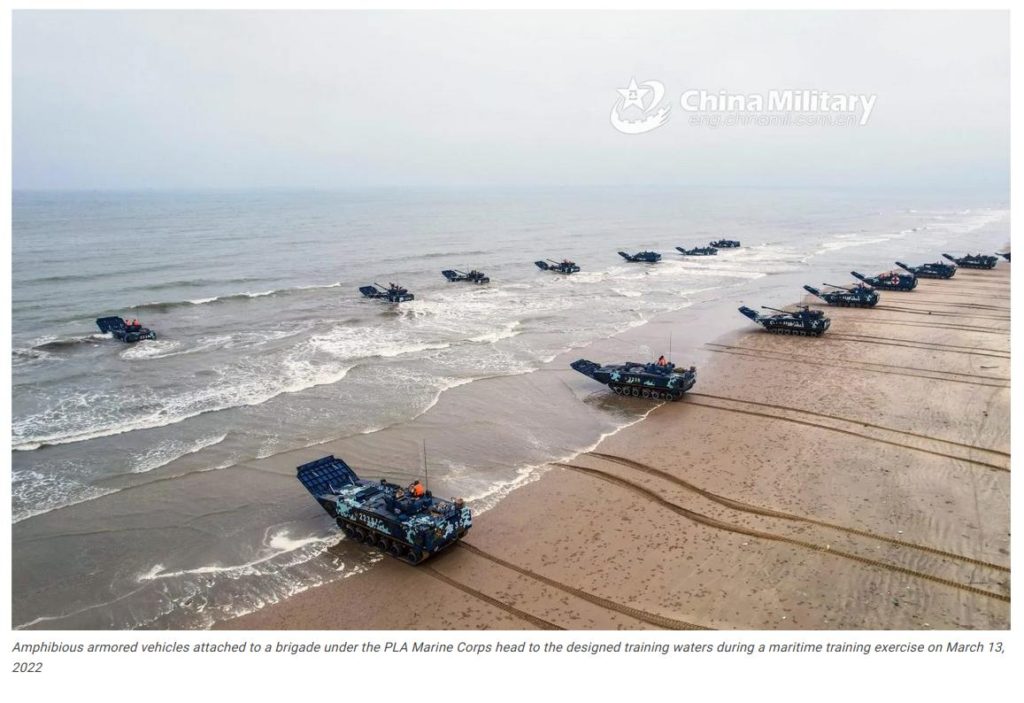
Need For A Fresh Strategy
This doubt is based on the threat of overwhelming military force being brought to bear at a time early in the conflict that will make the goals of the aggressor unachievable. A denial strategy requires the will of the defending nation to back up its rhetoric with action when necessary.
This strategy is believed to be more expensive because it requires more ready deployed forces, and it may also require the will to potentially use these forces in pre-aggression phases of conflict.
On the other hand, a punishment strategy seeks to deter an aggressor by the threat of pain if they take aggressive action. This strategy does not reveal one’s strength fully and keeps the adversary guessing.
This strategy implies that a nation will not or cannot decisively foreclose objectives to the adversary, and instead hopes that an adversary’s pain threshold can be overwhelmed into submission.
In a sense, it is an ambiguous proposition. But this is said to be cheaper because it requires fewer forward-deployed forces, thus less force structure. It is also politically more palatable because popular support will be more forthcoming after adversaries initiate aggression.
Most importantly, this strategy facilitates what Chief of Naval Operations (CNO) Admiral Mike Gilday says “divest to invest” so that the US navy is more capable and more lethal. But the issue is that its eventual success rests on many “assumptions”, which the US Congress wants to be clarified.
Nanking Cargo: Riches From the Orient
Article HERE
It’s the kingdom of power and awe where the winds wail, the gulls cry and the sea surges. Only the bold will brave it. Gales may blast it, rains may flood it and tides may churn it, but it is and always will be…the South China Sea.
Ask Michael Hatcher and he’ll tell you about raging storms, dark waters and pirates that he faced in an unforgiving environment unwilling to give up its treasure even to the bravest of souls. Hatcher never considered himself brave. Lucky perhaps, but not the daring swashbuckler portrayed in Hollywood productions. His demeanor, quiet, cordial and determined, was a perfect match for his line of work: Professional Treasure Hunter.
The South China Sea wasn’t unfamiliar to the Yorkshire, UK, orphan who grew up on a farm in the Australian outback. He picked up various jobs on land until age 27 when he bought his first boat. It took a lot of time and hard work, but by 1977 he had formed his own company and was salvaging scrap metal from sunken WWII vessels. Avoiding monsoons and standing up to modern-day pirates was standard operating procedure for the adventurer called “Hatch” by friends and crew.
Hatch greeted Lady Luck with a smile in 1983 when he stumbled upon a 17th century Chinese junk that went down on Admiral Stellingwerf Reef in the South China Sea. He and his crew salvaged more than 20,000 pieces of late Ming and Traditional Period Chinese porcelain that netted $2 million at Christie’s Auction House in Amsterdam. Hatch was ecstatic. Money to operate the boat, pay the crew and purchase high tech equipment was always a concern, but now he had the resources. Now he could make a mighty push in trying to locate the big “G.”
The Geldermalsen, a Dutch East India company merchant vessel, sank in a storm in 1752. The 1,150 ton vessel was on a return voyage from Canton to Amsterdam laden with Chinese porcelain, tea, raw silk and gold. Accounts from the survivors verified the shipment along with records in Holland whose trade with Asia for two centuries was dubbed the Golden Age. Along with his partner, Max de Rham—an engineer skilled in high technology and marine surveys—Hatch researched the merchantman. Both agreed to begin the search in the area where the Chinese junk was found. Using satellite navigation, proton magnetometers and side-scan sonar, they swept a five mile perimeter, but came up empty handed. After two months of fruitless effort, Hatcher wanted to quit, but de Rham begged for one more day. Bingo! The very next day, May 11, 1985, the prize appeared on sonar—an image of a shipwreck showing mastheads, cannons and deck contours.
Hatch and de Rham were the first down and right off the bat found shards with the luster of cobalt blue beneath a ceramic glaze. Their expectations soared as pairs of dive teams uncovered crate upon crate of blue and white teacups, bowls, butter tubs, dinner plates, teapots and more. Serendipity kicked in when the divers realized the crates of porcelain had been cushioned upon impact by the bags of tea. More good fortune emerged when they recovered 127 gold bars in the captain’s cabin.
Diving conditions were hazardous. Silt swirled around as cargo was removed, forcing divers to work by feel. Large bags of tea leaves broke free from their containers prompting Hatch to declare, “It was like swimming around in a giant black teapot.” The 132-foot depth and dark waters were ominous. Using surface air supply, hoses had to be monitored and bottom time computed. Getting the bends was always possible, but the salvors were experienced divers who stressed safety first. Divers entered a decompression chamber after each turn on the wreck. Storms delayed progress and lookouts packing guns stood guard against interlopers. After 10 weeks of long hours and intense labor, a container ship arrived to haul off 1,400 cartons of the Hatch’s cache. Upon arrival in Holland, it took six people, working steadily for one month, to unpack, clean and stack more than 170,000 pieces of china.
The payoff came in April, 1986, when Christie’s of Amsterdam opened a five day auction of the “Nanking Cargo.” An official from Christie’s coined the name, Nanking, the main distribution center for Chinese porcelain shipped to Europe throughout the years. It had an appealing ring to it and helped prices soar beyond auction forecasts. More than 20,000 people attended the auction, many harboring a desperate desire to own a memento from this romantic treasure trove. An anonymous bidder paid $332,786 for a 144-place dinner setting, while a Swiss banker bought a pair of butter tubs for $15,275. A small stoneware jug went for $5,251. In all, the sale brought in $15.3 million, double the pre-auction estimates. Gold soared as well, netting a Midas touch that bordered on $2 million.
As for Hatch, the 45-year-old salvage entrepreneur, this was a happy moment, but one he never looked back upon. Like all steadfast adventurers, he went off searching for another wreck in the untamed South China Sea. When asked by a reporter to give up one of his secrets to success, he responded with one word: “experience.” His mantra throughout all of his exploits has been, “Experience is the best teacher.” That being the case, Hatch, the student, continues to earn straight A’s.
China and Singapore to resume military exercises, cooperate on defence education
Article HERE
- Analysts say the developments are a ‘natural progression’ of warming defence ties between China and the city state, which also has strong strategic ties with the US
- A question that will be raised is ‘the level of exposure both sides would have to each other’s doctrine and equipment’, one observer says

China and Singapore’s defence ministers on Thursday said joint military exercises suspended during the Covid-19 pandemic were set to resume, and pledged to deepen defence ties in their first face-to-face meeting since 2019.
Chinese Defence Minister Wei Fenghe and his Singaporean counterpart Ng Eng Hen held talks at the inaugural Singapore-China Defence Ministers’ Dialogue, where they discussed global security issues, a statement from the city’s defence ministry said.
The two defence ministers also shared their respective views on bolstering defence exchanges between China and Asean, the statement said.
A Survey Of Corporate Financial Officers Found That 100 Percent Of Them Expect A Recession To Start In The Months Ahead
Have you ever heard of a survey where 100 percent of the respondents agree? I can’t ever recall seeing one like that, but as you will see below, 100 percent of the corporate CFOs that were just surveyed by CNBC believe that a recession is coming by the end of next year. At this point, our economic troubles are growing so rapidly that you would have to be deaf, dumb and blind not to see what is happening. A meltdown of historic proportions has already begun, and there is economic gloom just about everywhere that you look.
But even though the U.S. economy is clearly moving in one direction, I still didn’t expect to see this sort of a consensus among corporate financial executives…
According to the majority (68%) of CFOs responding to the survey, a recession will occur during the first half of 2023. No CFO forecast a recession any later than the second half of next year, and no CFO thinks the economy will avoid a recession. The CNBC CFO Council Q2 survey is a sample of the current outlook among top financial officers. It was conducted among 22 chief financial officers at major organizations between May 12-June 6.
Of course they are right on target.
The months ahead are going to be very difficult.
And with each passing day we continue to get more evidence that the economic slowdown is accelerating. For example, it appears that a “transportation recession” has already begun…
A downturn, if not a full-on recession, is clear in the transportation world. While the rest of the economy debates whether things are that bad, it’s been clear for months to logistics providers that the situation has worsened — and the velocity of that change is still stunning. The cost to move a container from Asia to a major port in North America or Europe has sunk by 23% since the beginning of this year, according to maritime research firm Drewry. Spot rates have plummeted even faster; marketplace Freightos said rates from China to the West Coast are down 38% month-over-month. FreightWaves forecast this week that ocean shipping volumes will “drop off a cliff” by this summer, based on slumping bookings out of China.
Meanwhile, the most absurd housing bubble in the history of our country is clearly starting to burst. Compared to a year ago, mortgage applications were down a whopping 21 percent last week…
This just keeps getting worse: Applications for mortgages to purchase a home dropped 7% for the week, and were down 21% from a year ago, the Mortgage Bankers Association reported today. An indicator of future home sales: Potential homebuyers try to get pre-approved for a mortgage, lock in a mortgage rate, and then start house-hunting. Mortgage rates have soared this year, and home prices have soared for years to ridiculous levels, causing layers and layers of potential buyers to abandon the market, amid “worsening affordability challenges,” as the MBA called it.
On top of everything else, jobless claims just shot up to their highest level in almost six months…
The number of Americans filing for unemployment benefits unexpectedly jumped last week, spiking to the highest level since mid-January in a sign the hot labor market could be starting to cool. Figures released Thursday by the Labor Department show that applications for the week ended June 4 rose to 229,000 from an upwardly revised 202,000 a week earlier, missing the 210,000 forecast by Refinitiv analysts. It marked the biggest one-week increase since last July. The four-week average of new claims, which smooths volatility in the weekly figures, also increased slightly to 215,000 last week.
But even though all of these numbers clearly indicate that a “recession” is coming, a potential “recession” is not the number one economic concern for most Americans.
That is because the worst inflation crisis in modern American history is hitting all of us extremely hard.
According to a FiveThirtyEight/Ipsos poll that was just released, 52 percent of Americans believe that inflation is “the most important issue facing the country” right now…
At this point, the answer to what Americans are most worried about is pretty straightforward: inflation. In the first FiveThirtyEight/Ipsos poll, 52 percent of Americans said the most important issue facing the country was inflation. We asked Americans this question in a variety of ways, but regardless of how we asked it, the top answer was always the same: inflation.
Other surveys have come up with similar results. For example, just check out these numbers from the Pew Research Center…
Seven-in-ten Americans view inflation as a very big problem for the country, followed by the affordability of health care (55%) and violent crime (54%). About half say gun violence and the federal budget deficit are very big problems (51% each), according to a Pew Research Center survey conducted April 25-May 1 among 5,074 U.S. adults.
Inflation is something that the American people can see on a daily basis.
On Thursday, the average price of a gallon of gasoline in the United States hit five dollars a gallon for the first time ever.
And as I pointed out the other day, experts are warning that it will soon cross the six dollar threshold.
The grocery store is another place where all of us can clearly see the rampant inflation that is happening. A single shopping cart of food can easily cost $300 these days, and that is absolutely insane.
Unfortunately, this is just the beginning, and most Americans realize this. In fact, one survey just discovered that approximately two-thirds of us expect inflation to get even worse over the next year…
The Federal Reserve, the Biden administration, and Wall Street’s economists are confident that inflation will be brought down over the coming year. The American public disagrees. Two-thirds of Americans say they expect inflation to get worse over the next year, according to a poll conducted by The Washington Post and George Mason University’s Schar School of Policy and Government.
Some of us have been warning for years that the decisions that our leaders were making would destroy the stability of our currency.
Now nightmarish inflation is officially here.
And some of us have been warning for years that our rapidly growing long-term economic problems would eventually result in a meltdown of epic proportions.
Now that meltdown has begun.
Our fate could have been very different if we would have chosen a much different path while we still had the chance.
But now it is too late, and the pain that is ahead is going to be greater than many Americans will be able to handle.
1957 America. Some Say This Time Was Paradise.
Do you want more?
You can find more articles related to this in my latest index; A New Beginning. And in it are elements of the old, some elements regarding the transition, and some elements that look towards the future.
New Beginnings 5.
Articles & Links
Master Index.
- You can start reading the articles by going HERE.
- You can visit the Index Page HERE to explore by article subject.
- You can also ask the author some questions. You can go HERE to find out how to go about this.
- You can find out more about the author HERE.
- If you have concerns or complaints, you can go HERE.
- If you want to make a donation, you can go HERE.
.

